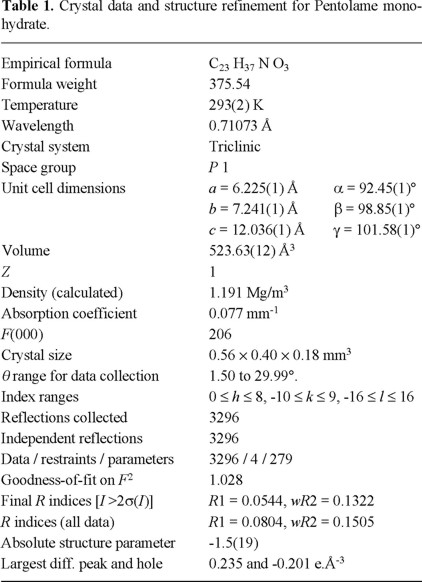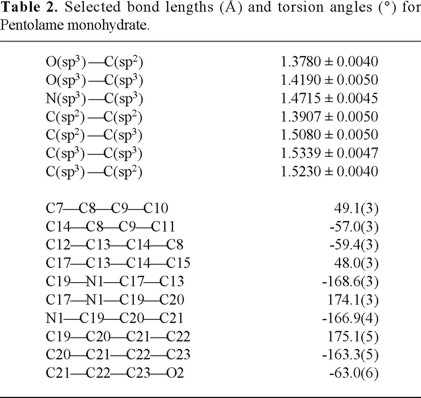Services on Demand
Journal
Article
Indicators
-
 Cited by SciELO
Cited by SciELO -
 Access statistics
Access statistics
Related links
-
 Similars in
SciELO
Similars in
SciELO
Share
Revista de la Sociedad Química de México
Print version ISSN 0583-7693
Rev. Soc. Quím. Méx vol.48 n.4 Ciudad de México Oct./Dec. 2004
Investigación
Confirmation of the C-17 Stereochemistry of Pentolame by Single Crystal X-ray Analysis of its Monohydrate
Cristina Lemini,1 Ruth Jaimez1 and Rubén A. Toscano2*
1 Departamento de Farmacología, Facultad de Medicina, Universidad Nacional Autónoma de México. Circuito Interior, Ciudad Universitaria. México D. F. 04510, México.
2 Instituto de Química, Universidad Nacional Autónoma de México. Circuito Exterior, Ciudad Universitaria. Apartado Postal 70-213. México D. F. 04510, México. E-mail: toscano@servidor.unam.mx
Recibido el 12 de octubre del 2004.
Aceptado el 9 de noviembre del 2004.
Abstract
The molecular and crystal structure of Pentolame, a 17β-aminoestrogen (17β-(5'-hydroxy-1'-pentylamino)-1,3,5(10)-estratrien-3-ol), has been determined by single crystal X-ray diffraction as its monohydrate. The structure was used to determine the absolute configuration of the newly formed stereogenic centre (C17), which could not be established unambiguously by NMR spectroscopy. This study confirms the absolute configuration as 17S by internal reference with the starting material, estrone [(8R,9S,13S,14S)-3-Hydroxyestra-1,3,5(10)-trien-17-one]. Pentolame monohydrate crystallizes in the triclinic system, space group P 1 with Z = 1. The B ring adopts the typical conformation of a distorted 7α,8β-half-chair. In crystal packing, the water molecule plays an essential role joining adjacent infinite chains, made up by head to tail hydrogen bonded steroid molecules.
Key words: Pentolame, 17-amino-estrogen, X-ray analysis.
Resumen
En este trabajo se determinó por difracción de rayos X, la estructura molecular y cristalina del 17β-aminoestrógeno Pentolame. Su estructura se investigó a fin de determinar sin ambigüedades la configuración absoluta del nuevo centro estereogénico (C17) formado durante su obtención. Los resultados obtenidos mediante referencia interna al material de partida, estrona [(8R,9S,13S,14S)-3-Hidroxiestra-1,3,5(10)-trien-17-ona], confirman la asignación 17S hecha en base a los datos de espectroscopía de Resonancia Magnética Nuclear. El monohidrato de pentolame cristaliza en el sistema triclínico, en el grupo espacial P 1 con una molécula por celda. El anillo B de la molécula, adopta la conformación típica 7α,8β de media silla observada en este tipo de esteroides. En el empacado cristalino la molécula de agua desempeña un papel esencial uniendo cadenas infinitas adyacentes, formadas por interacciones de puente de hidrógeno entre la "cabeza" y la "cola" de dos moléculas del esteroide.
Palabras clave: Pentolame, 17-amino estrógeno, análisis por rayos X.
Dedicado a la memoria del doctor Raymundo Cruz Almanza
Introduction
As part of our studies directed towards the preparation of compounds as alternative therapeutic agents for prostatic cancer, the menopausal syndrome, and estrogenic components of oral contraceptives, we prepared the 17β-aminoestrogen pentolame (1) [17β-(5'-hydroxy-1'-pentylamino)-1,3,5(10)-estratrien-3-ol] (Figure 1). Pentolame produced sustained anticoagulant effects opposite to that showed by estradiol upon blood coagulation in rodents [1]. The estrogenic activity of pentolame on endometrial, pituitary and gonadotropin release [2] is similar to that of estradiol with lower potency. The aim of the present work was to carry out the X-ray analysis of this compound in order to ascertain its molecular structure, to confirm structural assignment made mainly by NMR and to establish unambiguously stereochemical relationships. The crystal structural data presented here will be useful for the improvement of structure-activity studies related to the design of new agonistic and/or antagonistic analogues of sex steroids with tissue specific actions and disease-prevention benefits.
Results and Discussion
Although the strict and demanding criteria of Flack and Bernardinelli [3] are not met in this study, it confirms the absolute configuration by internal reference to the starting material (estrone). The stereochemistry of the title compound was determined by as (17S)-17β-(5'-hydroxy-1'-pentylamino)-1,3,5(10)-estratrien-3-ol.
All bond lengths and bond angles of the compound correlate well with the average values observed for 1,3,5(10)-estratriene steroids [4].
The molecule (excluding the axial methyl group and 5'-hydroxy group) may be regarded as being represented by essentially planar surface, lying almost parallel to the (001) crystal face, with the r.m.s, deviations of the atoms from the respective plane being 0.275 Å (1) The molecule is slightly twisted about the long axis, as shown by the angle which has the methyl bond, C13—C18, with the nuclear plane, angle observed 3.2 °. The B/C and C/D inter-ring junctions have been flattened from 120º (for cyclohexane) to around 130 ° (Table 2), thus producing an overall nuclear length, C3—C16, of 8.978 Å that agrees with the usual slight downward bowing found in steroids.
Nevertheless, the 5-amino-1-pentanol side chain shows an orientational disorder involving the carbon atoms C21 and C22; the major contributor displays an extended conformation except for the hydroxyl group orientation, which is evidently influenced by the hydrogen-bond interactions in the crystal (vide infra).
The A ring shows typical aromatic character with a ϖ electrons delocalization to produce an average bond length of 1.391 Å.
The B ring has a half chair conformation, with C8 lying 0.41 Å above, and C7 0.37 A below the plane of atoms C5, C6, C9 and C10 carbon atoms. The distortion in the B ring is mainly the result of a twist about the C7—C8 bond to accommodate the strong interaction between the aromatic hydrogen atom H(1) and the equatorial hydrogen atom H11B of the C ring; the distance between these two hydrogen is 2.141 Å.
The C ring is in an ideal chair conformation and the D ring of Pentolame has a 13β-envelope conformation.
The crystal packing is illustrated in Fig. 2; it shows a projected view downward b. The steroid molecules are hydrogen bonded head to tail: O2 . . . O1 (x, y+2, z+1) with O . . . O = 2.790 (4) Å and O-H...O = 174 (5) °, and form infinite chains parallel to c. The water molecule plays an essential role joining adjacent chains by forming hydrogen bonds with the amino group: O3 . . . N1 (x, y, z-1) with O . . . N = 2.873 (4) Å and O-H...N = 177 (5) °; with the hydroxyl group: O3 . . . O2) (x+2, y-1, z-1) with O . . . O = 2.827 (4) Å and O-H...O = 174 (6) ° and with the phenolic hydroxyl group: O(1) . . . O(3)(x, y-1, z) with O . . . O = 2.642 (4) Å and O-H...O = 167 (6)°.
Experimental
All solvents and reagents were analytical reagent grade and were used without further purification. Estrone was obtained from Syntex, and 5-amino-1-pentanol, and lithium borohydride from Aldrich. Proof of chemical purity was established by normal spectral (IR, NMR, MS) and analytical (TLC, and chemical analysis) techniques. Melting points were determined on an Electrothermal capillary melting point apparatus (Mod 9100), and are uncorrected.
Synthesis of 17β-(5'-Hydroxy-1'-pentylamino)-1,3,5(10)-estratrien-3-ol (pentolame). A mixture of 1.5 g (5.5 mM) of estrone and 1 g (9.7 mM) of 5-amino-1-pentanol and 10 mL of isopropyl ether were heated until dissolution. The solvent was evaporated and the reaction mixture was kept at 80-85 °C for 4 h. It was cooled to room temperature and the solid formed, triturated with acetone (30 mL). The resulting white solid obtained was filtered and dried in vacuum to give 1.87 g (98 % yield) of product, mp 178-180°C. This product (4.5 mM) was dissolved in ethanol (20 mL), and lithium borohydride (1.0 g) was added portion wise over 30 min. The reaction mixture was heated at reflux for 30 min. After cooling the solution with an ice bath, water was added (100 mL); the formed precipitate was filtered, washed thoroughly with water, and dried. Pentolame was crystallized several times from methanol-water by an evaporation method. Its spectroscopic properties were similar to those reported previously [5]. This material was used both, in biological assays [1] and for the crystallographic study.
Crystals suitable for X-ray analysis were grown from methanol-water solution by slow evaporation. The data were collected on a Siemens P4/PC diffractometer [6], with graphite monochromated Mo-Ká. The accurate unit cell dimensions were obtained by the least-squares method by setting angles of 35 reflections (5º < θ < 12.5º). The θ/2θ scan method and a variable scan speed, depending on reflection intensity, were used. Three control reflections were measured after every 97 reflections and showed no systematic changes during data collection. Intensity data were corrected for the Lorentz and polarization effects [6]. The structure was determined by direct methods and refined by the full matrix least-squares method with the SHELXTL program [7]. Refinement was carried on F2 with scattering factors incorporated in SHELXL97. The function Σw( |Fo |2 - |Fc |2)2 was minimized with w-1 = [σ2(Fo)2 + (0.0745 P)2 + 0.80 P]. All non-hydrogen atoms were refined with anisotropic thermal parameters. The coordinates of the hydrogen atoms involved in hydrogen bonds OH· · ·O, were found in difference Fourier syntheses and their positional parameters were refined. The coordinates of the other hydrogen atoms were calculated from the geometry and refined as a riding model with their displacement parameters calculated as 1.2 times Ueq that of the carrier carbon atom. The crystallographic data, together with data collection and structure refinement details are listed in Table 1. Selected bond lengths and torsion angles for the compound are listed in Table 2.



The displacement ellipsoid representation of the molecule, together with the atomic numbering scheme and the crystal packing, are shown in Figure 1. Additional crystallographic data have been deposited with the Cambridge Crystallographic Data Centre as supplementary publications No CCDC- 252511.
Acknowledgement
In Memoriam. Raymundo Cruz Almanza will be sorely missed as supervisor, friend, and collaborator. A generation of students and colleagues at all levels benefited from his insightful, thoughtful, and caring interactions.
References
1. Lemus, A. E.; Jaimez, R.; Lemini, C.; Menjivar, M.; Silva, G.; Rubio-Póo, C.; Valenzuela, F.; Larrea, F. Steroids 1998, 63, 433-438. [ Links ]
2. Jaimez, R.; Cooney, A.; Jackson, K.; Lemus, A. E.; Lemini, C.; Larrea, F. J. Steroid Biochem. Mol. Biol. 2001, 73, 59-66. [ Links ]
3. Flack, H. D.; Bernardinelli, G. J. Appl. Cryst. 2000, 33, 1143-1148. [ Links ]
4. Duax, W. L.; Weeks, C. M.; Rohrer, D. C. Top. Stereochem 1976, 9, 271-383. [ Links ]
5. Lemini, C.; Rubio-Poó, C.; Silva, G.; García-Mondragón, J.; Zavala, E.; Mendoza-Patiño, N.; Castro, D.; Cruz-Almanza, R.; Mandoki, J. J. Steroids 1993, 58, 457-461. [ Links ]
6. Siemens. XSCANS User's Manual. Version 2.1. Siemens Analytical X-ray Instruments Inc. Madison, Wisconsin, USA 1993. [ Links ]
7. Sheldrick, G. M. SHELXTL (Version 6.10). Bruker AXS Inc., Madison, Wisconsin, USA 2000. [ Links ]














